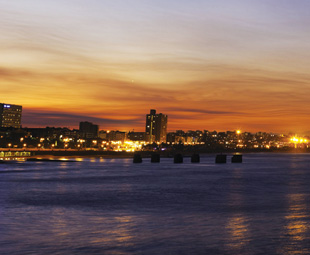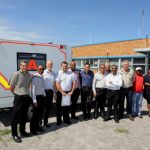Seas of change

The ocean plays a major part in how the world moves freight. FOCUS takes a look at what role the Eastern Cape plays in our country’s maritime economy and features the province’s latest port
Mfundo Piti, economic infrastructure development manager at the Coega Development Corporation (CDC), says it best: “With thousands of kilometres of coastline, South Africa is in a prime position to maximise on its ‘blue gold’. The Eastern Cape, with two major port cities, and two established industrial development zones (IDZs) is particularly well placed. This will enable Nelson Mandela Bay and East London to become leading hubs of maritime economic activity.”
He adds that government’s plans, unveiled at the beginning of this year, aim to address widespread poverty, unemployment and socio-economic inequality by building an operational, turnkey ocean economy. “Two decades from now, it is believed that South African maritime-oriented economic activities will contribute an estimated R177 billion to gross domestic product,” Piti continues.
“Ports have always been at the forefront of maritime economic organisation, catalysing economic growth through the trade of manufactured goods, commodities and raw materials,” he points out. “As both entry and exit points, the two Eastern Cape ports are critical to the present and future of the province and indeed the country.”
An important indicator of the province’s (and our country’s) growing maritime economy is the Port of Ngqura, 20 km northeast of Port Elizabeth. “Adjacent to the Coega IDZ, the deep-water seaport is becoming the fastest-growing terminal in the world, according to Drewry Maritime Research,” says Piti. “Seaports help to transform underdeveloped regions into important trade centres, which in turn support job creation,” he notes.
He adds that world sea traffic passes by the Eastern Cape on the east-west pendulum trade routes, opening up major opportunities for ship building and repairs in the region.
“Last year, the world merchant fleet comprised 106 833 vessels shipping goods and commodities between the continents, including visits to the three ports of the Eastern Cape,” Piti points out. “During 2013, about 5 944 container ships, vessels and tankers were commissioned for construction by various countries.”
Currently, South Africa’s ship-building industry holds international credibility with activities taking place at shipyards in Cape Town and Richards Bay. “However, the Eastern Cape’s world-class industrial manufacturing industry will make the province an excellent contender for future shipbuilding activities in the ocean economy,” explains Piti.
“Existing expertise, skilled labour, logistics services, skills related to the automotive and manufacturing industries as well as other ancillary services from the manufacturing industrial base will be highly attractive for domestic and foreign direct investment.”
He continues: “While automotive manufacturing is the dominant industry in both Nelson Mandela Bay and East London, the expertise of these industrial hubs should be extended to the ship building and other industries.”
This is exactly what Transnet Port Terminals (TPT), an operating division of state-owned logistics company Transnet, is doing. To meet the growing demand of vehicle exports, TPT’s East London Multi-Purpose Terminal (MPT) has initiated innovation in the form of containerisation of cars, rather than driving them directly onto the vessel. This is expected to ensure faster turnaround times for the terminal, as well as economic spin-offs for the region.
This new car containerisation project, which has been in operation since December 2014, is set to increase automotive volumes by 22 000 per annum and increase 20-ft equivalent units (TEUs) by 14 600 TEUs per annum. TPT has invested R200 000 to ensure that the East London MPT has adequate infrastructure needed for the project.
Says Prince Mangayi, operations manager at the East London Car Terminal: “TPT is excited to implement this new method of transporting cars. It will provide our clients with access to new export markets and innovative supply chain solutions. In addition, this project will boost the much-needed volumes for the auto sector, building foreign direct investment confidence for East London.”
Siyabulela Mhlaluka, TPT’s general manager for the Eastern Cape operations, adds: “In support of economic growth in the region, Transnet Port Terminals continues to find ways of diversifying its services to meet customer demand.”
The wonderful thing about containerisation is that the containers can be moved between ships, trains and trucks without re-handling the contents, thereby increasing production output. Mangayi adds: “Since the inception of this new project, the East London MPT showed a three percent increase in volumes.”
Nelisiwe Mbenekazi, terminal manager at the East London MPT, continues: “It is expected that the project will promote job creation and skills development, thereby positively contributing towards the TPT business and the East London economy.”
There are exciting things ahead for the maritime activities of the Eastern Cape and South Africa. “There are many signs that we are on the right track,” says Piti. “Nelson Mandela Bay and East London should be united in ensuring we are key role-players and benefactors of the ocean economy. It is especially necessary because in the Eastern Cape poverty remains widespread, deep and intergenerational, in relation to other provinces.”
The West Coast also delivers …
In the main article, the importance of the east coast in our country’s maritime economy is highlighted, but the west coast holds equal stature – especially the Port of Saldanha …
As stated on the Transnet National Ports Authority’s webpage: “Situated some 60 nautical miles north-west of Cape Town, the Port of Saldanha has, since its discovery in 1601, remained the largest and deepest natural port in the southern hemisphere. It is able to accommodate vessels with a draft of up to 21,5 m.
“The port covers a land and sea surface of just over 19 300 hectares, within a circumference of 91 km, with maximum water depths of 23,7 m. Saldanha is unique in that it has a purpose-built rail link, directly connected to a jetty bulk-loading facility, for the shipment of iron ore.”
ALE, an international heavy transport and installation contractor, discovered that this port was also perfect for another purpose. The company was awarded the contract for the port operations, transport to site, mechanical and electrical erection and installation of 37, V100-1.8 MW, wind-turbine generators (WTGs) with hub heights of 95 m, at a new wind farm in the Western Cape.
“We were responsible for receiving all components transported to an intermediate handling area, which enabled quick vessel discharge, at the Port of Saldanha,” says Theo van Wyk, account and brand manager of ALE’s South African brand.
“There were three shipments containing blades, towers, nacelles and hubs. From there, the components were re-loaded and transported to the wind farm, situated approximately 60 km from the port.”
He adds that this was no small undertaking. The scale, volume of cargo and time pressure required careful planning and scheduling. “With the WTG components being grouped per tower, it was imperative that all components were handled, tracked and supplied correctly, to ensure a smooth and continuous operation.”
Published by
Focus on Transport
focusmagsa




